ROCKNA
DAC
the Romanian
Princess wants to marry the Transport King.
Well, after two
encounters with Audio Note DAC4 Signature sound - I
could not get rid of that memory, the sensation of a total,
unconditional, unlimited musical JOY.
Since I don't
remember the last time I had 20 000 dollars ready to
spend on a DAC, I thought to myself: why not be a smartass and make
something like that myself???
Seems like a
good idea. After all, Audio Note just uses Analog Devices
chip AD1865, a power supply and two tubes. Could not be any simpler
than that.
So I browsed the
internet searching for AD1865 products or just the
chip. Well, except a couple of Wadias - I found almost NOTHING. Well -
not exactly nothing because I found ROCKNA.
The AD-LABS
company from ROCKNA group prepared something just for
me - a simple, one PCB, fully functional DAC with the superb chip
in the centre.
http://www.audiokit.ro/img/photo/dac.jpg
From what they
say on the website - their DAC is just what I need. A
simple, basic board with the great chip and everything according to the
Rockna guy - is well thought about.
So I bought it
blindly without investigating further.
What
irritated me was the order processing and handling. I
had zero
feedback, not only inside the DAC circuit but also from the
Rockna company about my shipment.
4 weeks later I
decided to write it off. Purchase was not on Ebay, so I
had no protection. What the hell, I thought, health is what matters,
160 Euro is unimportant.
Just 5 weeks
later - Rockna DAC arrived. Very quietly, not like a real
Princess, she arrived in bubblewrap envelope. Just when I least
expected it and forgotten the 160 Eu already.
FROM ROCKNA DAC
PAPERS:
http://www.audiokit.ro/dac_rd3.html

RD-3 is available in 2 versions:
without AD1865*
139 €
with AD1865N-J
169 €
RD-3 assembled : 259 €
AD Labs presents the new RD-3 D/A converter. Instead of relying only on
spdif receiver pll (CS8416) for jitter reduction like concurrent
offerings, the RD-3 features a custom reclocking technique (ART) built
with Xilinx programable logic, external analog loop and MAX9485 low
jitter master clock generator. This stage perfectly locks on the clocks
generated by CS8416 and delivers low jitter output, while keeping
perfect audio data integrity. The reclocked signals are routed directly
into AD1865 which is well known as one of the best R2R dac available. A
zero-feedback, fully discrete i/v converter delivers pure analog
quality at the output.
Details:
input frequencies : 32, 44.1, 48, 88.2, 96, 192 Khz
number of inputs : 2 (optical, coaxial)
S/N ratio: 102 dB
THD : 0,06%
IMD : 0,04%
Low impedance output (30 ohms)
Bandwidth : 20 Hz - 20 Khz, +/- 0.5 dB
Featuring ART - Audiokitlabs Reclocking Technique
zero-feedback discrete output stage
board dimensions : 107 x 100 mm
microcontroller operated
Soooo, this
looks very interesting. Not another ME TOO design, unlikely
another Chinese Counterfeit of a famous design, and not another
"chip data sheet suggested evaluation board made to look commercial".
Just a proper result of someone's best efforts.
I must admit
that the price (considering this is EU remember ?)
is fair for this top level of PCB craftsmanship. The PCB looks much
better that what I am used to,
I listened
briefly in stock form. The PCB played immediately without
surprises. But the sound was not impressive at all. I felt
disappointed. Such good DAC, zero feedback, zero oversampling, simple
circuits, and above all - discrete output stage. No opamps, no
overengineering - my expectations were much higher.
So I expected a
big change after lampization.
ROCKNA DAC MEETS
DOCTOR LAMPIZATOR
Before Rockna
could marry the King Transport, she had to see the doctor
first. I took her two legs (4, 21)and lifted them from the sockets. The
now
floated legs became I outputs potentially offering highest sound
quality.
I did not even
question the power supply - it looks good and it is all
SMD. It also is a DEDICATED design. So it's gotta be good.
Here is the
point when I had to decide the voltage conversion - famous
I/U.
I know Mr.
Qvortrup puts a Sowter transformer between the DAc and the
tube grid. Since sowters are costing more that the whole bloody DAC, I
decided to use a resistor.
The resistor
works great in all other DACs so it should work here too.
We can also
refer to one of the greatest DAC designs available for DIY
- published in Audio Express June 2006. made something similar
to A-N DAC4 - namely - AD1865 plus Sowters plus SRPP.
http://www.geocities.com/yury_g/dac.htm
or the audionote version:
http://www.audionotekits.com/dac2_1.html
BACK TO ROCKNA (is it Dracula or is it Nadia Comaneci ?)
About the chip:
The DAC is an
old 18 bit stereo design, single ended only.
FROM DAC
DATASHEET
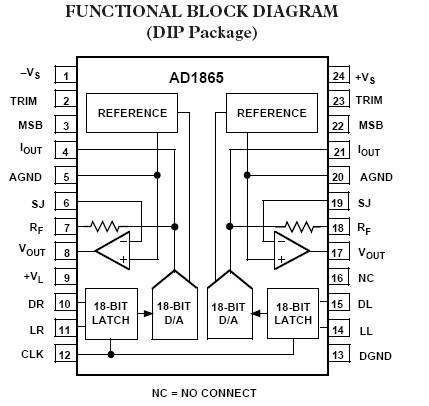
AD-1865 datasheet
excerpts :
FEATURES
Dual Serial
Input, Voltage Output DACs
No External
Components Required
110 dB SNR,
0.003% THD+N
Operates at 16 3
Oversampling per Channel
Cophased Outputs
116 dB Channel
Separation
Pin Compatible
with AD1864
APPLICATIONS
Multichannel
Audio Applications
Compact Disc
Players
Multivoice
Keyboard Instruments
DAT Players and
Recorders
Digital Mixing
Consoles
Multimedia
Workstations
PRODUCT
DESCRIPTION
The AD1865 is a
complete, dual 18-bit DAC offering excellent THD+N and
SNR while requiring no external components. Two
complete signal
channels are included. This results in cophased voltage
or
current
output signals and eliminates the need for
output
demultiplexing circuitry. The monolithic AD1865 chip includes
CMOS logic elements, bipolar and MOS linear elements
and
laser-trimmed thin-film resistor elements, all fabricated on Analog
Devices’ ABCMOS process.
The DACs on the
AD1865 chip employ a partially segmented architecture.
The first four MSBs of each DAC are segmented
into 15
elements. The 14 LSBs are produced using standard R-2R
techniques. Segment and R-2R resistors are laser trimmed to provide
extremely low
total harmonic distortion. This architecture minimizes
errors at major code transitions resulting in low output
glitch and
eliminating the need for an external deglitcher. When used
in the current output mode, the AD1865 provides
two ±1 mA
output signals. Each channel is equipped with a high
performance output amplifier.
These amplifiers
achieve fast settling and high slew rate, producing
±3 V signals at load currents up to 8 mA. Each output
amplifier is
short-circuit protected and can withstand indefinite short
circuits to ground.
The AD1865 was
designed to balance two sets of opposing requirements,
channel separation and DAC matching. High channel
separation is
the result of careful layout. At the same time, both
channels of the AD1865 have been designed to ensure
matched gain and
linearity as well as tracking over time and
temperature. This assures optimum performance when used in
stereo and
multi-DAC per channel applications.
Vassili list of
all other AD1865 machines
|
AUDIO NOTE CD-2
|
AD1865 – SM5843
|
KSS-210 / SOH-A1
|
|
AUDIO NOTE CD-2.1x
|
|
AUDIO NOTE CD-3
|
AD1865 – SM5843
|
SOH-A1
|
|
AUDIO NOTE CD-3.1x
|
AD1865N
|
|
WADIA 23
|
2 x AD1865N – XC3042A
|
Pioneer Stable Platter
|
|
WADIA 12
|
2 x AD1865
|
It’s a DAC
|
Well -I ended up
(after potentiometer test) using 330 Ohms as
conversion resistor. It was soldered directly into the tube socket
between pins 7 and 9 (with 6N2P tube that is).

The yellow cubes
are SMD type of Tantalum resistors. Great stuff for
digital - superfast caps on supershort legs.
The DAC as you
see is the best selection N-J (or is K better perhaps ?)

Rockna DAC -
full view from power supply side. This board has all PS
elements - AC bridges, ripple filters cLc, regulators, capacitors and
everything. So only a transformer is needed with 9 VAC and 12-0-12 AC
secondaries. Power can be small - the whole thing draws not more that
tens of milliamps.
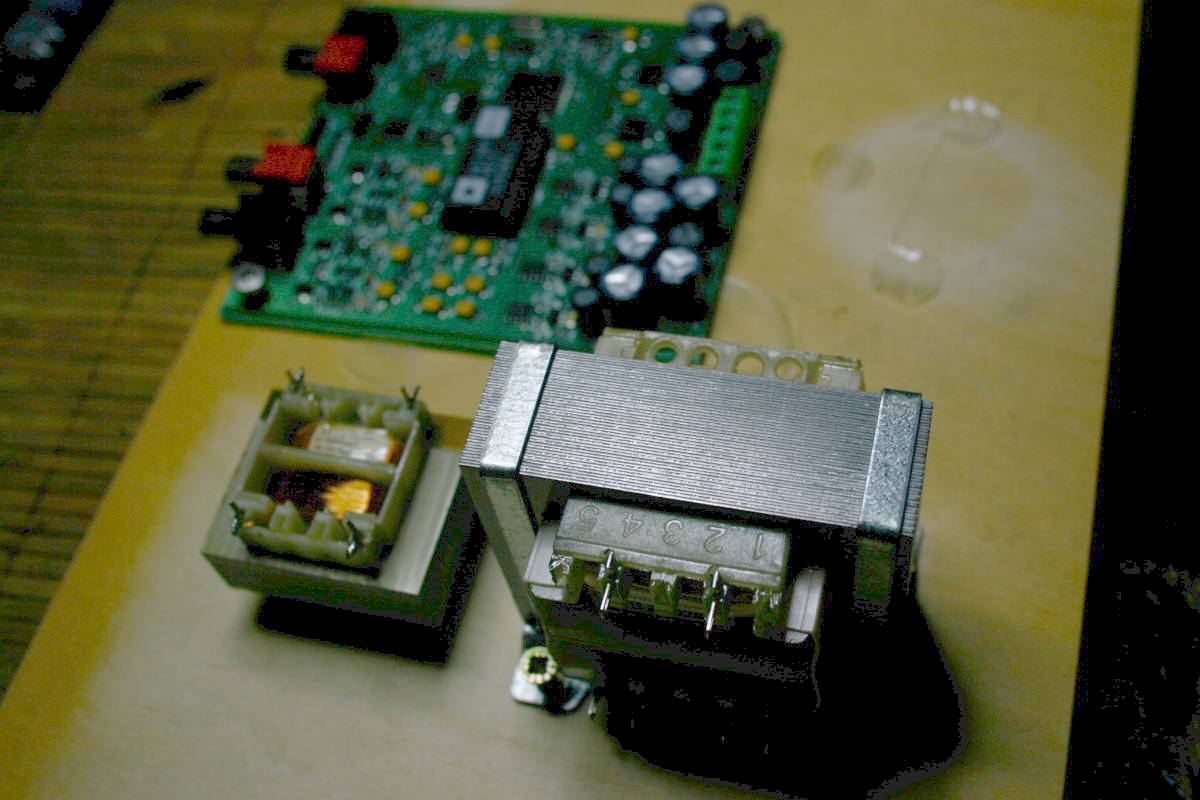
Above: the
aforementioned transformers.
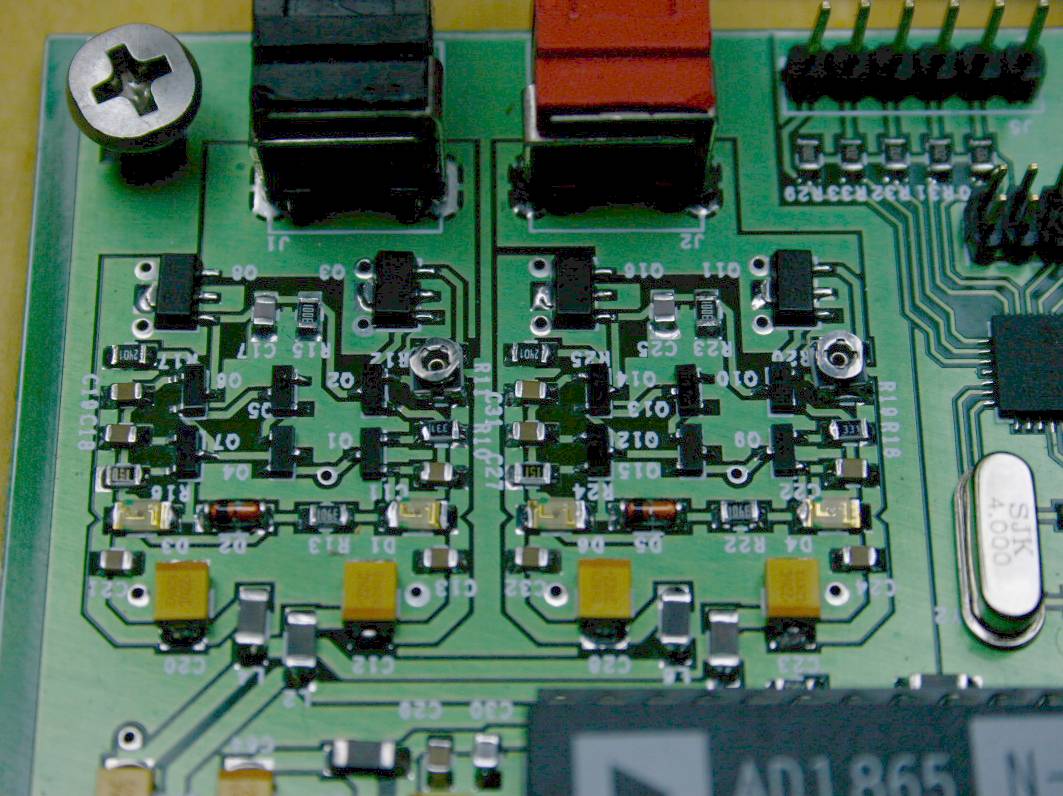
Above: the
discrete transistor output stage. Promising and
disappointing.
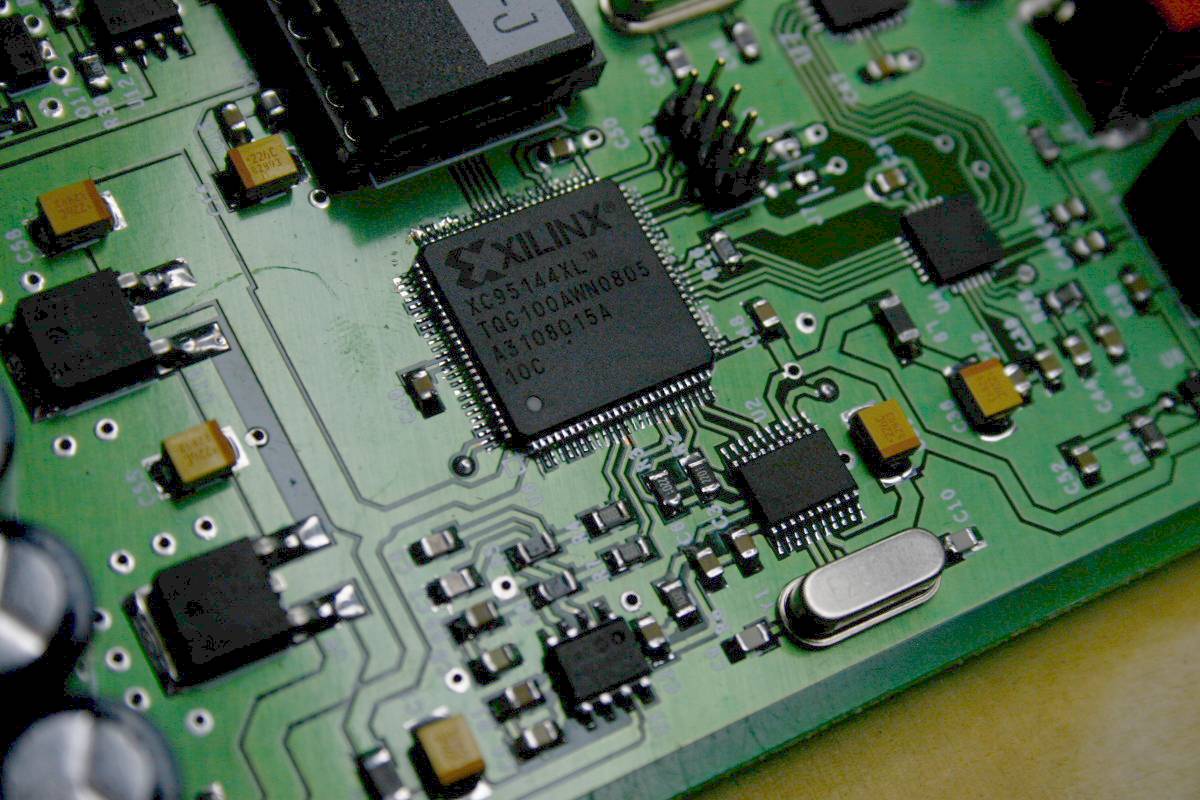
This is the "god
knows what for" Xilinx processor. I bet it is very
important.
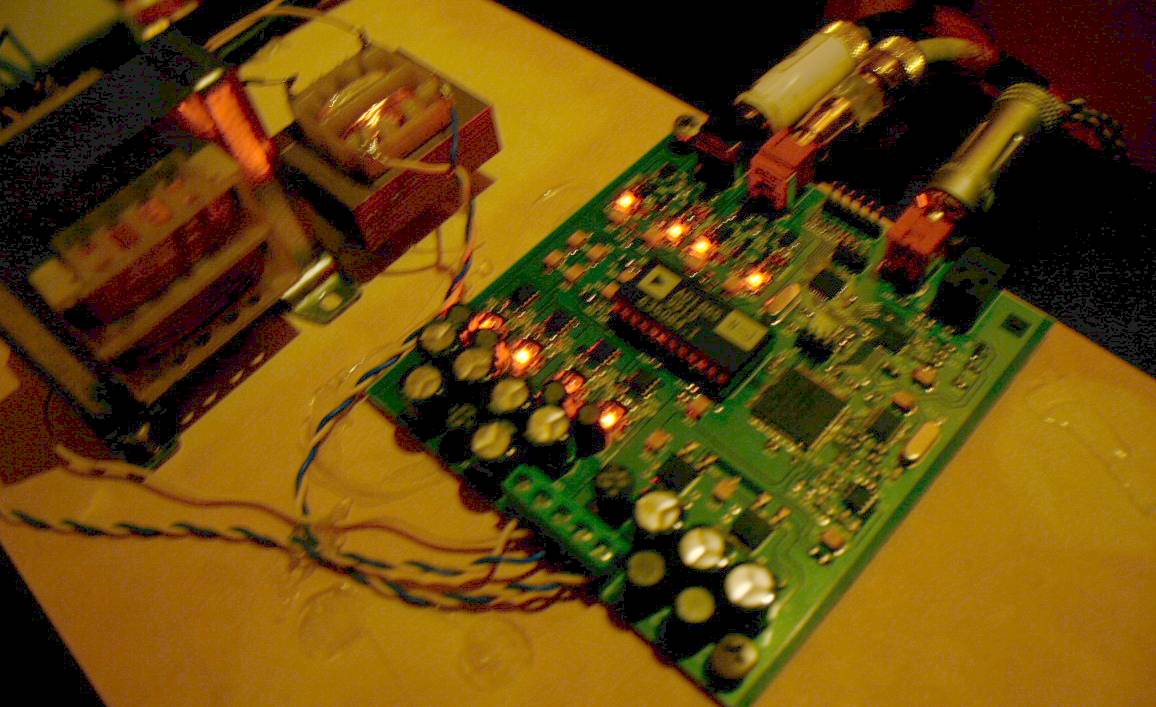
The DAC
surprised me by having an array of 8 LEDS informing about the
proper power supply to the various sections of a DAC. A nice touch.
Very comforting.

Beauty contest
during the Third Battle of Giants. In left bottom corner
- TDA1541 Green Dac (unnecessary parts unpopulated) on right bottom -
MaxiLampucera DAC with CS4397 dac chip, in top row - Buffalo
Sabre Dac QSS from Twisted Pear.
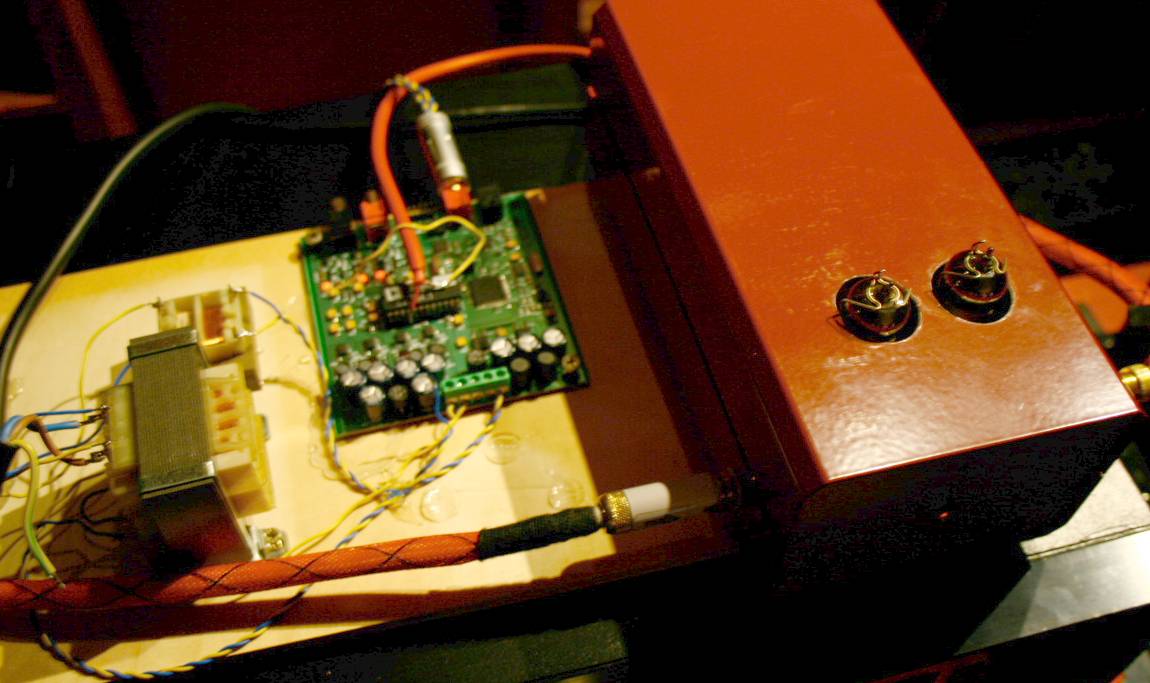
ZE SOUND
Hey Romanian
Princess, I am surrounded by the whole bunch of
supermodels, so you better try hard.
Honestly, the
lampized DACk ROCKNA plays very well. First: no nasty
surprizes, no humming, no noises, no pops or clicks. Clean sound.
It is just about
equal with the good players like Lampucera, Zero Dac,
or non-NOS (regular) TDA1541A. It is just equal to Burr Brown PCM58
like in Sony 338ESD.
But I expected
more. I expected extasy and hallucinations. I knew I
cant make audionote DAC4 for 200 Euro but subconciously I was hoping to
get very close.
I don't know if
it is the digital front circuit (with reclocking and
some DSP chip XILINX) or maybe it is the lack of transformer for I/U
conversion. I will install my Sowters and report back if the
thunderrous, totally enveloping magically analog sound will appear.
Maybe AD1865 does not like resistive conversion. Even, if
lampized DACK sounds 3 classes better than the stock unit, it requires
probably much more attention than one evening. I will not give
up, you can quote me on that.
I will start by
lifting the other legs unused: 6, 7, 8, 17, 18, 19.
Maybe that will open up the sound.
2 weeks
later.
I lifted legs
6,7,8,17, 18, 19 - still no nirvana.
I tried
different tubes, but the sound remained a little bit clinical,
mechanical, like OKAY sound but not what I paid for.

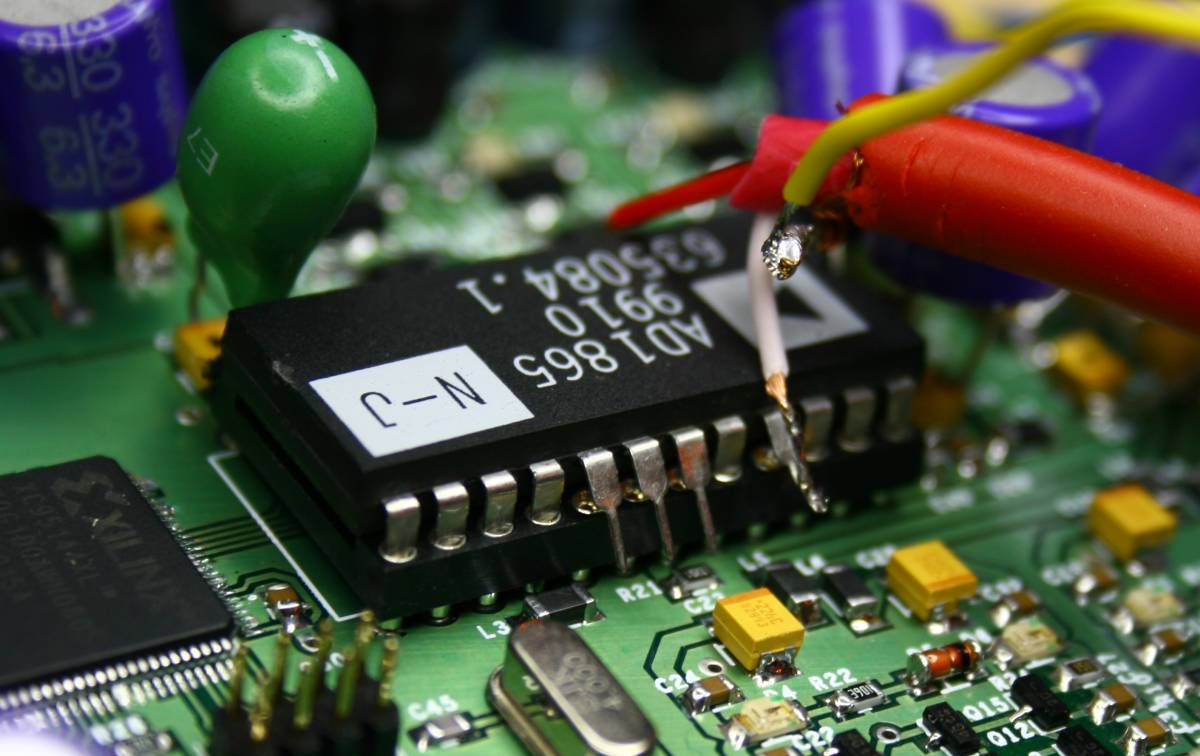
In desperation I
thought about the caps. The power supply utilizes
first some generic electrolytes, then chokes, then regulators, and
after regulators
- SMD tantalums (the yellow cubic stuff).
The tantalum is
great for some applications, but it tends to sound dry,
dimensionally flat and with lifted trebles.
So I soldered
the OS-CONs - 220 uF by 6,3 V across every tantalum except the four
plus one , whch power the unused output stage.
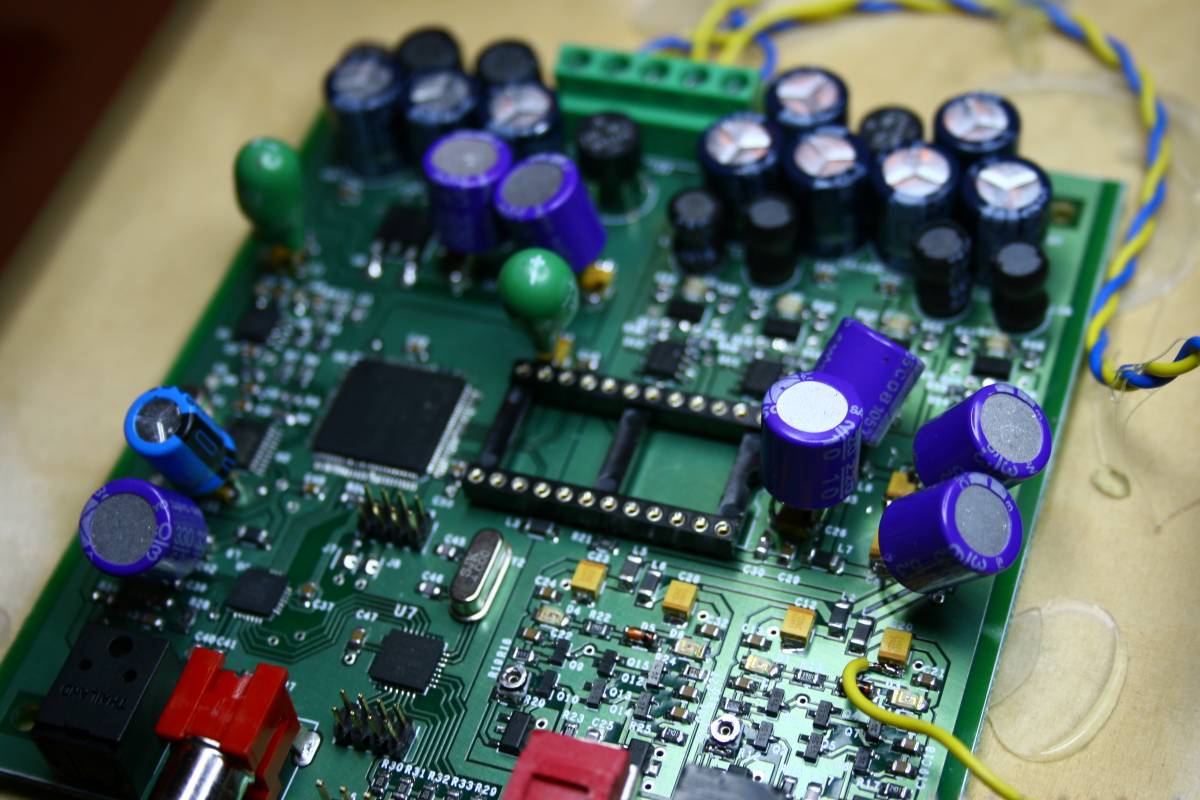
When I run out of oscons, I substituted the Tantalum 33uF/25V in less
critical areas (green headed caps)
On the photo below it is shown which caps DO NOT need Oscons across
them. All
other yelow cubes should get upgraded capacitors soldered on top of
them in parallel.
Given the magnitude of improvement which the cheap os-cons gave
me,
I can only imagine what the much better but also more costly Blackgates
would do to this DAC.
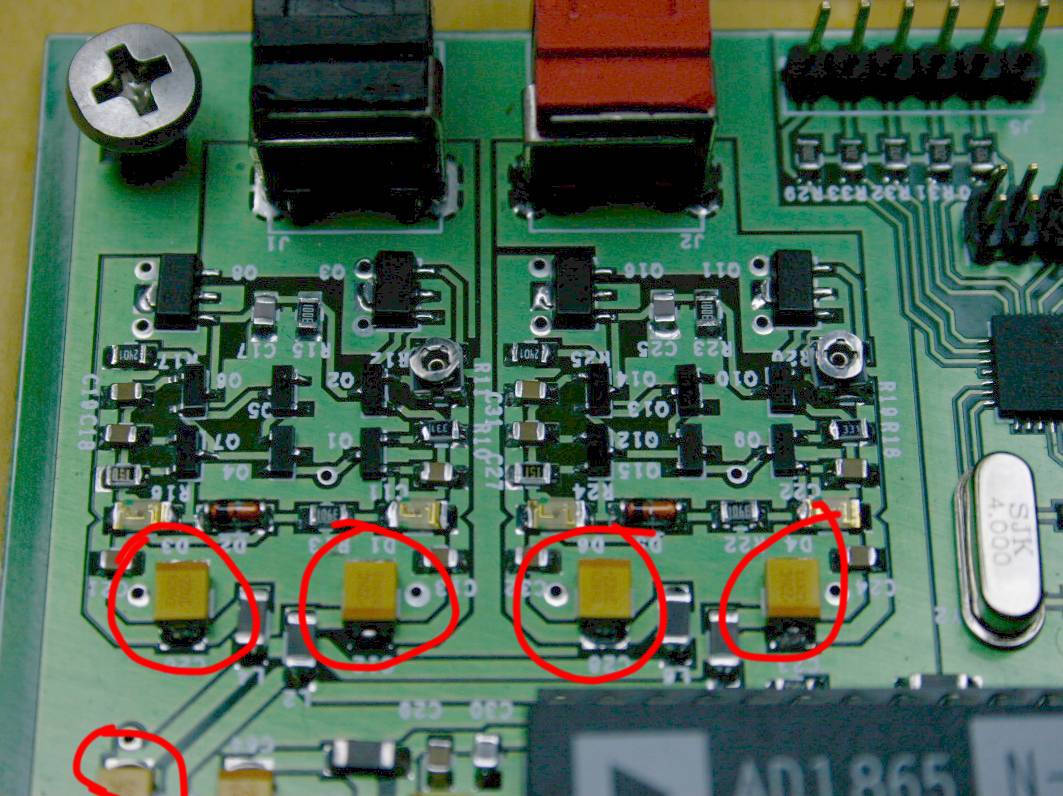
Again - DONt upgrade these caps in red circles. Upgrade all other.
AFTER OSCONIZATION of Rockna PCB
OOOooo much
better. From the first note the expanded space stroke me as
something new. The sound became MUCH more analog like, spacious,
delicate, with stronger bass, much closer to Nirvana. Much closer
to the best DACs out there. The OSCON soldering took literally
10 minutes and it is reversible.
It is already
great sound, but I will investigate further. Maybe
I should disable the reclocking circuit, such action improved the SATCH
dac a lot. Maybe I will ask the creators of this dac what the varous
jumpers
are for.
Till next time,
Lukasz
The story of
Rockna - Romanian Princess of DACs - ends in happy end marriage
with the Prince of Transports who totally unexpectedly came from USA
and captured the hearts of all
After osconization my breadboard Rockna kit sounded good enough to
treat it seriously. It sounds DIFFERENT from my beloved TDA1541A, and
actually I like it more and more.
I used a very nice (even if too goldish for my taste - case from Hong
Kong ($60)
http://cgi.ebay.com/ws/eBayISAPI.dll?ViewItem&item=230306982182
from biglawhk company (Mr. Lawrence)
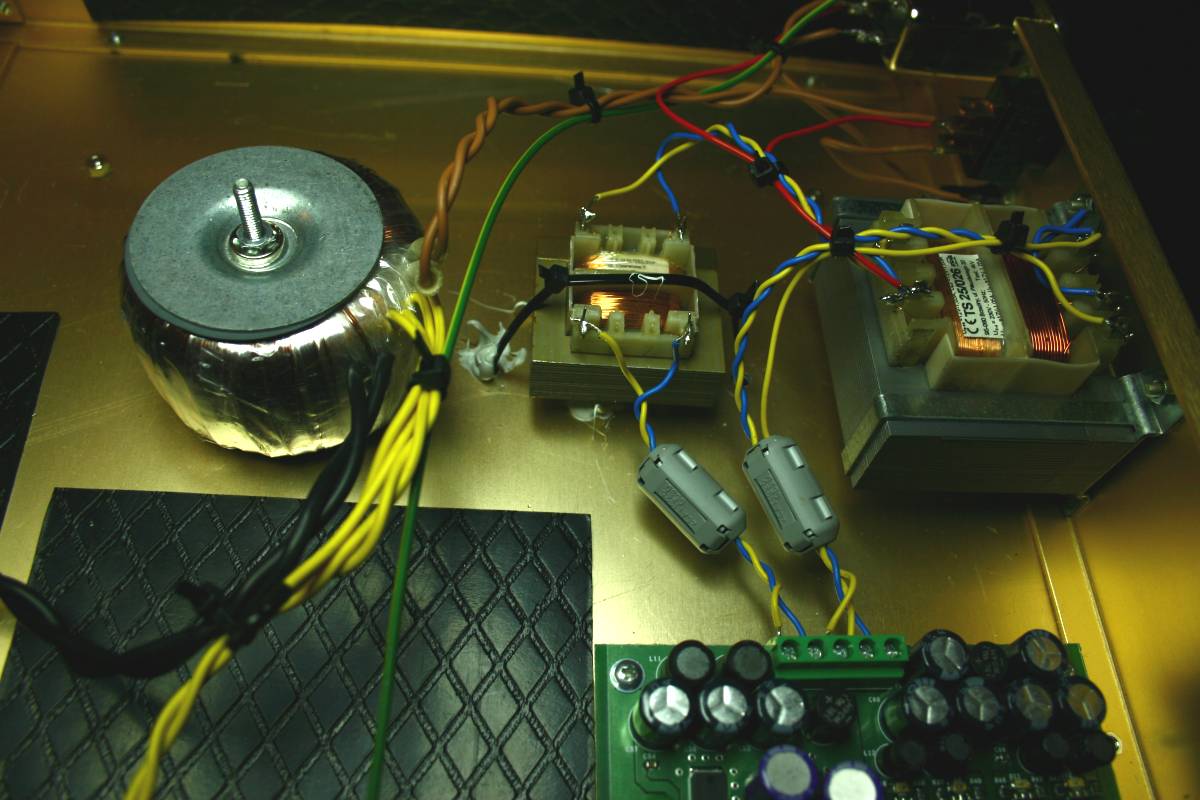
As you see - I used 3 transformers - one for 12-0--12 V, one for 9 V
(both for Rockna) and the Lampizator one.
I had two secondaries for anode supply - 120 V each. Instead of using
it in stereo dual supply, I opted for series connected secondaries
producing 240V AC and after rectification - 320 V DC. I used one supply
set of caps and filters and BOTH stereo tubes are supplied from common
point. This is simple and in SRPP (constant current) it does not cause
stereo crosstalk.
Heating is provided for two tubes by series 12,6VDC - 6,3 V per tube.
I tried 4 different tubes and definitely the 6H6P sounded best. IDEAL !
The resistors are 1K in all four cathodes and the DAC is in current
output mode - its output is wired directly to a 330 Ohm resistor (tube
leg 7 to ground).
There are no capacitors between DAC and tubes.
Output caps are Paper In Oils - russian MBGO military types - 1 uF by
400 V plus a 5 nF styroflex bypass.
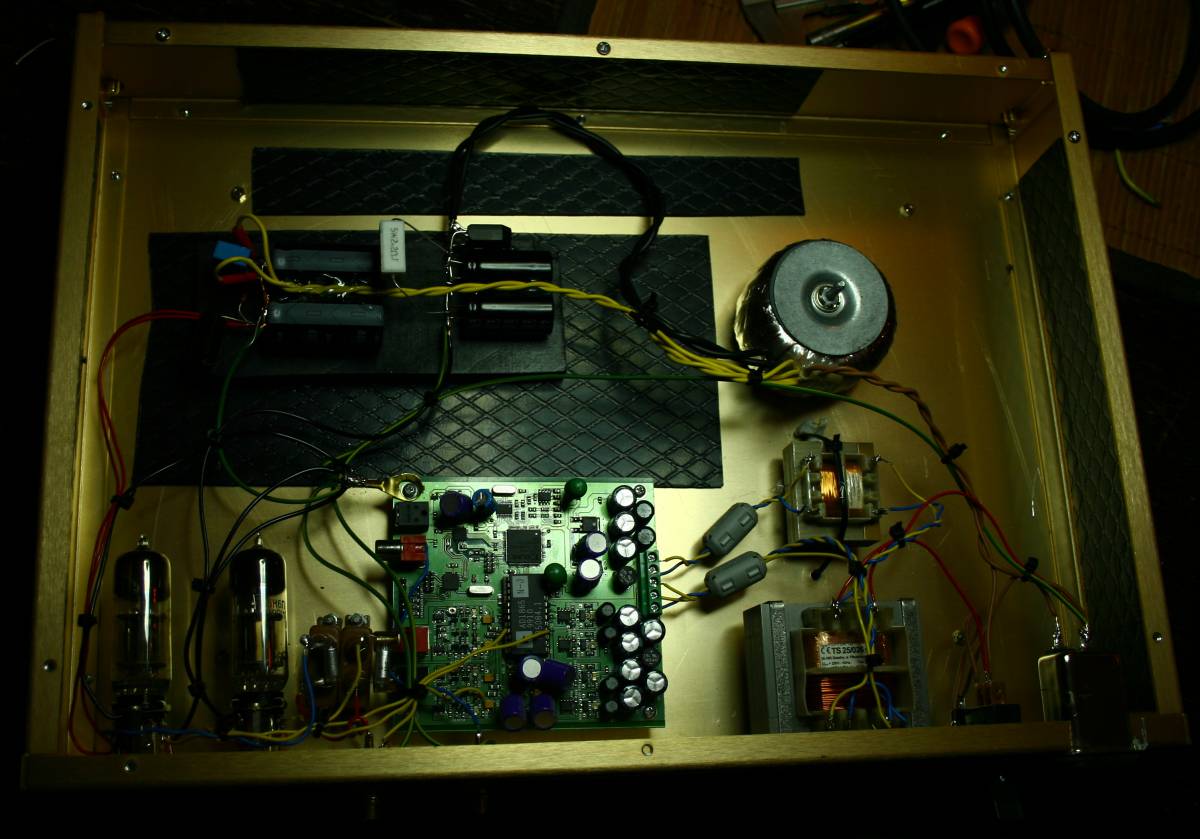

I used bituminous felt generously because the box has large surfaces.

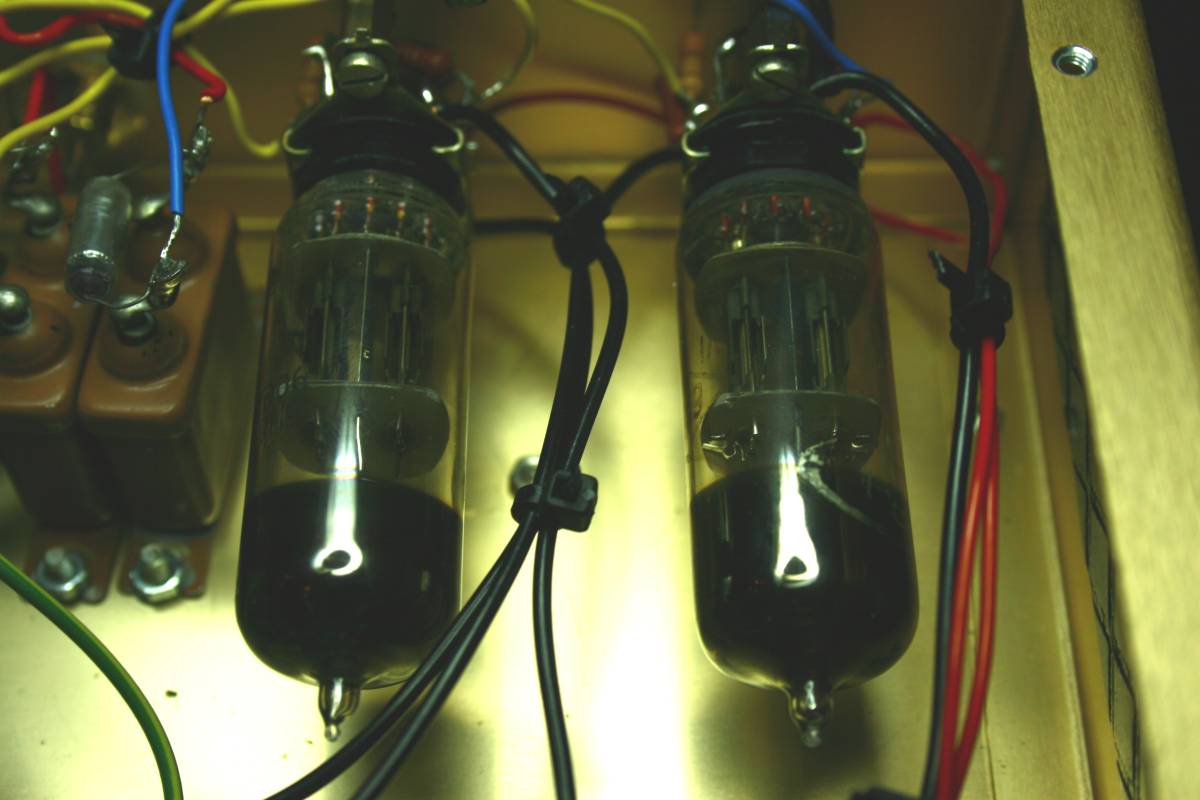

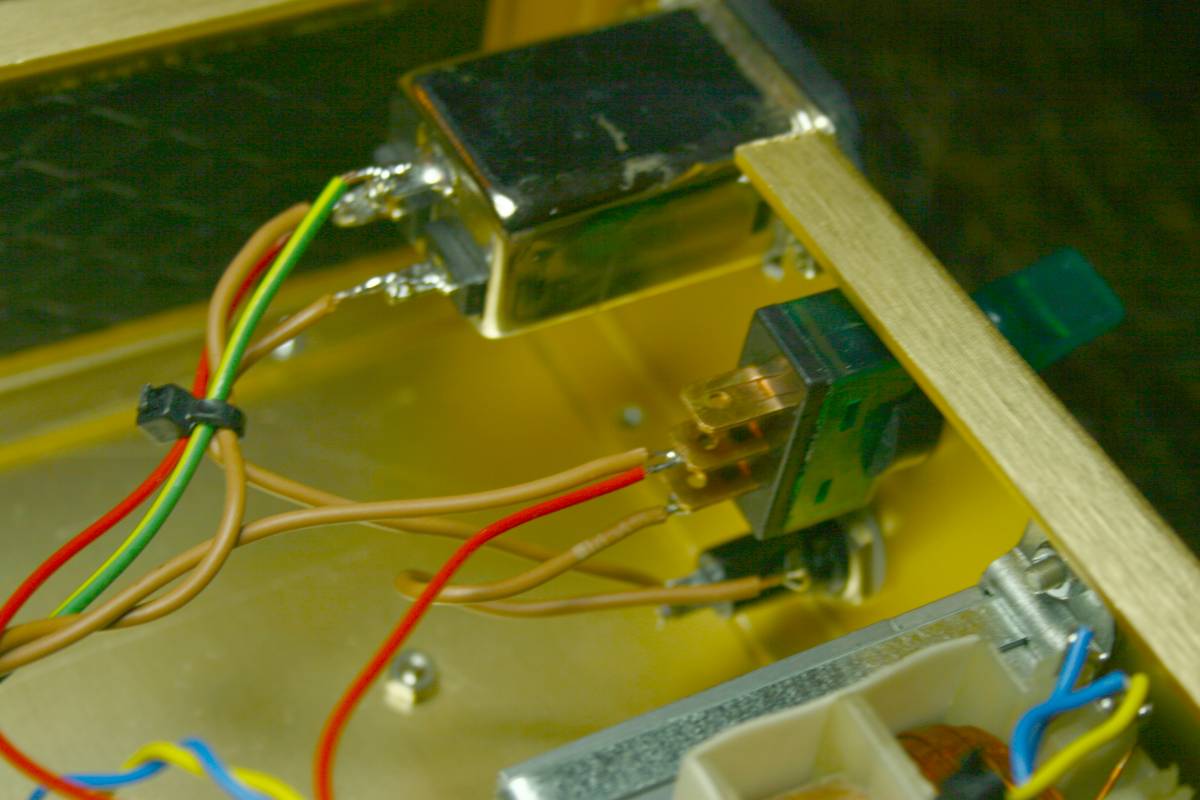
Lampi- Rockna DAC and Theta Data Transport - match made in
heaven, also visually

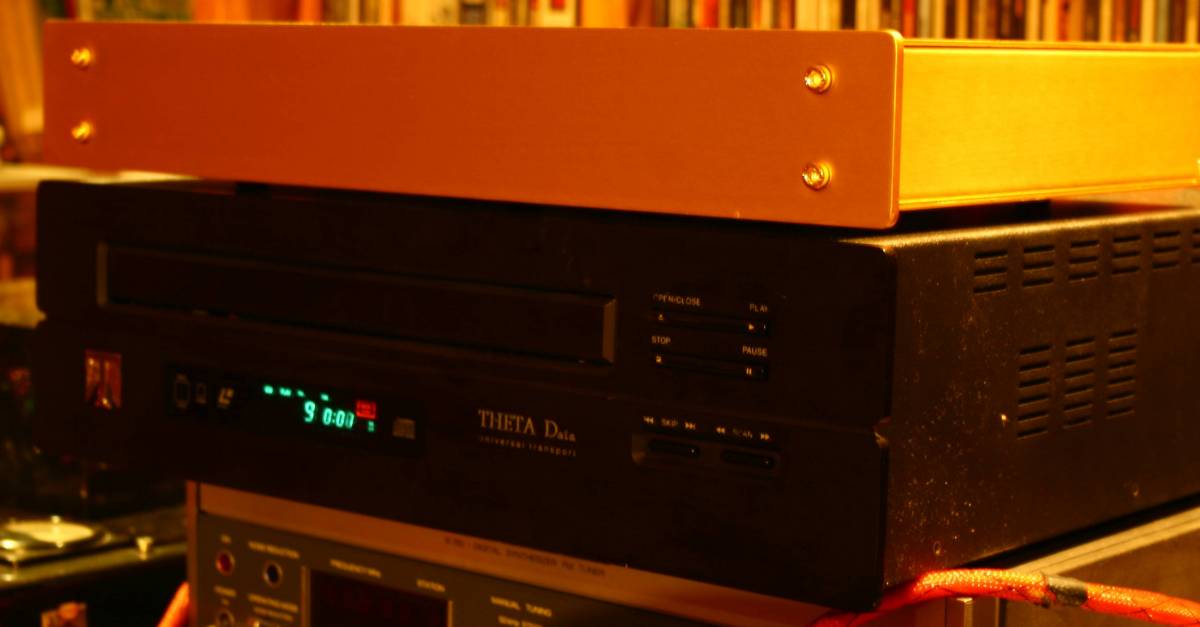

It did not happen overnight but the process of improving the Rockna
finally paid off. I had to lampize it, build all custom power supplies,
add new oc-con caps and marry it to the very capable transport.
But the end result is extremely good. I don't have today the Buffalo
Sabre ESS dac for comparison but generally speaking - the Rockna/Theta
combo is world class performer. I rank it equally to the best ones:
Sabre, Grundig 9009, Sony 555ESD, Lampucera and Naim CDS.
I am not yet sure if the Rockna can be any good with a lesser transport
than that bloody monster.
Anyway - The two products together do something VERY right and the
sound without doubt takes another dimension.
Also please read about the
Theta itself.
I also am not impressed with ADLABS
company job. They use fine dac chip but they dont' provide application
that does it justice. Audionote does a much better job.
I heard that They make already an upgraded version, according to Mr.
Nicolae Jitariu
from ADLABS the new one is MUCH better. Time will tell. But to pay 170
Euro for the dac chip and the "holder" is not something like a
superdeal. If the Rockna board does not significantly add to the
stellar performance of the chip - I would rather build one DAC from
scratch or try a Chinese cheap alternative or really go for the
Audionote kit.
If you already own the DAC from ADLABS - you are welcome to try my
approach. The sound is really good.
A year later
A year later I still could not live with the gap between
Audionote DAC4 and the modded Rockna.
I bought the new receiver chip - CS8414 and I wired it to the AD1865
chip directly, without ANYTHING AT ALL taken from Rockna board.
This way it became a puristic totally kosher totally NOS version of
Andrea Ciuffoli DAC.
http://www.audiodesignguide.com/DacNoOverSampling/index.html
below is the AD datasheet
http://www.audiodesignguide.com/DacNoOverSampling/AD1865.pdf
Below is the comment from Audio Note datasheet of product:
The DAC uses the revolutionary and
currently exclusive Audio Note digital
technology dubbed 1x oversampling™
direct from disc™ circuit topology. The
technology in essence dispenses with
all the correction measures inherent in all other
D/A converters and presents the
digital signal directly to the converter after
reformatting. In other words, all
products in the Audio Note DAC range have no
oversampling, no jitter reduction, no
noise shaping and no re-clocking. Having
removed all the digital filtering
that is part of the oversampling, we have also
dispensed with all filtering in the
analogue domain to further retain good wide band
phase-frequency and dynamically
coherent behaviour. The end result being a
reproduction more reminiscent of
master tape in quality, with greater differentiation
and contrast between different
recordings.
Our converters all use a high grade
selected Analogue Devices AD1865, 18Bit stereo
converter chip because we found this
chip to be the best sounding available (yes, even
better than the 20Bit and 24Bit
versions!). This is fully compatible with 16-bit
44.1kHz technology as well as 48kHz
and can also be used with the 24-bit 96kHz
DVD-A standard as the DAC chip will
only loose resolution at the 20th, 22nd and
24th Bit, a truncation that mildly
reduces the resolution. Tests have shown that this
information loss is inaudible when
compared to comparable methods used in digital
technology, which involve either
oversampling, up sampling or other digitally derived
signal manipulations or
“improvements”.
And that's Ciuffoli applicfation in detail:
http://www.audiodesignguide.com/DacEnd/index.html
I tried it with one change - lampizator instead of his tube stage.
The end result is MUCH better than Rockna. Change of receiver chip from
CS8416 to 8414 and removal of XILINX resulted n such major jump in
transparency, clarity, easy flow, natural space. Almost Audionote
!
Just follow the Ciuffoli schamatics. It will get you as close to
nirvana as you can get for 100 Euro, all parts included. The only
situation when I was closer to Nirvana for 100 Euro was the other day
in Amsterdam, but that's another story.
The DAC Ciuffoli DAC can be wired on test pcb with holes in about
one eevening from scratch. You need 3 chips and a handful of oscons.
Audionote scematics:
3 weeks later:
I am very happy with my DAC which has now ZERO content from ROCKNA - it
is just the AD1865 chip with power supply and my own input chip.
Like a new forest that grows on the ashes of the old forest. It is a
new experience - showing that simple is better and that NOS rules.
The similar system - much cheaper and better built - can be had from
hong kong in form of DIY assembled kit.
I recommend everybody to buy
it immediately: NOS1865 DAC















